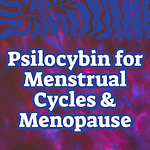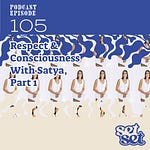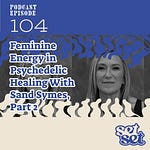Can weed make you trip like acid or mushrooms? In this week’s episode, April Pride unpacks the surprisingly psychedelic effects of cannabis—especially in potent doses. From the science of THC and the default mode network to the mysterious powers of new cannabinoids like THCP, this episode offers a fresh look at how weed can shift your sense of self, time, and the world around you. Plus, hear what happens when you mix cannabis with classic psychedelics like LSD or psilocybin—and why some folks swear it’s euphoric while others spiral into anxiety. If you’ve ever wondered whether weed is a psychedelic or how crossfading really works, this episode delivers clarity, curiosity, and caution.
🔵 Key Takeaways
THC impacts the same brain receptors as classic psychedelics—just with shorter, subtler effects.
High doses of potent weed can suppress the default mode network, producing psychedelic-like shifts in perception.
Combining cannabis with LSD or mushrooms intensifies the trip for some, while others report increased anxiety.
THCP is a new, hyper-potent cannabinoid that may explain wildly different high experiences.
Mixing psychedelics should be done mindfully—especially for newer users.
🔵 Timestamps
[00:10] Is cannabis a psychedelic? And what makes weed feel like tripping?
[01:18] THC and psychedelics in the brain—similar receptors, different outcomes
[02:49] Suppressing the default mode network: cannabis and psychedelics overlap
[04:03] Comparing the intensity and duration of cannabis vs. psilocybin or LSD
[05:27] Can weed reduce nausea on a trip—or make anxiety worse?
[06:28] Why everyone reacts differently when mixing substances
[07:47] Meet THCP: the cannabinoid 33x stronger than THC
🔵 Additional Resources
SetSet Blog: “Psychedelic Integration for Women”
SetSet Blog: “What is Cali Sober? A Drug Diet with Mindful Intent”
SetSet Blog: “The Perfect Cannabis Sesh A-Z”
Substack: “Psilocybin & Women, Survey Says”
How has weed shifted your perception—or helped (or hurt) a psychedelic trip? Have you felt the trippy side of THC? 👇 Let’s talk about it in the comments after the transcript below.
🔵 Transcript
[00:00] April Pride:
This podcast discusses cannabis and is intended for audiences 21 and over.
[00:10] April Pride:
Welcome to The High Guide. I'm your host, April Pride. There's no mistaking that [is cannabis a psychedelic] is a topic of growing curiosity, as we've discussed on the show before. And for those of us who have consumed some of this very potent [psychedelic cannabis effects], the effects produced can be nothing short of tripping. But should weed be considered a [psychedelic] and just where does it get these potent effects that teeter on the hallucinogenic side of things? This takes us to our glossary term of the week: THC, which is short for tetrahydrocannabinol. THC is the classic cannabinoid known for producing the high we receive from cannabis. If you're experiencing the psychoactive effects from weed, THC is definitely in the plant. In this week's episode, we'll unpack what makes cannabis a [psychedelic], which of course makes this plant similar to plants some may characterize as more "hardcore." We're also gonna discuss being [crossfaded experience]. No surprise that when you mix potent plants at the same damn time, things can get really out there.
[01:18] April Pride:
When it comes to [THC and the brain], one of the most crucial facets to understand is the specific parts of the mind and body they're affecting. While [classic psychedelics] do not interact with the endocannabinoid system, both cannabis and classic psychedelics such as LSD and psilocybin affect the 5-HT 2A receptor in the brain. Here, a psychedelic can bind to this receptor and help produce a trip that can last several hours. [Cannabis as a psychedelic] is capable of doing the same thing, but it will take a large dose of some very potent weed, and the duration will be significantly shorter, with effects likely fading within an hour. And while both can produce a change in perception of the world around you, a hallmark of the psychedelic experience, the ones produced by cannabis are considerably more subtle than those of a classic psychedelic. For example, taking a huge bong rip and watching the tree branches sway might produce some vivid colors. You might notice nuances in the movement you've missed previously. If you're tripping on LSD and looking at that same tree, it could very well be full-on dancing to whatever psychedelic soundtrack you've got pulsing through your body. These changes in perception, whether wildly visual and hallucinogenic in nature or more subtle like a breath of fresh air that resets the mind and body, are related to what's referred to as the default mode network—or more specifically, the suppression of it.
[02:49] April Pride:
According to a recent Leafly article titled, "[is cannabis a psychedelic]?", psychedelics suppress the default mode network—the DMN—in the brain, which allows an individual to look at a situation from a new perspective. Everything old becomes new again, and cannabis produces an effect similar to this. The DMN is a system responsible for processing self-referential thoughts like introspection, self-criticism, self-reflection, and autobiographical memory. Basically, if you're thinking about yourself, the DMN is likely involved. The suppression of the DMN can promote communication integration across different regions of the brain, changing perception and how you see yourself in relation to the world around you. However, the longevity of perceptual changes can differ between cannabis and [psychedelics like psilocybin]. Positive alterations in mood and outlook are short-lived in [cannabis-induced trips] compared to LSD or psilocybin. What's more, a [psychedelic trip] tends to last longer than a cannabis high. Magic mushrooms, for example—psilocybin involved there—can last an average of six to eight hours, while a weed high wears off after one to three hours.
[04:03] April Pride:
It's clear that cannabis and psychedelics both influence perception, but the effects of [psychedelic cannabis effects] are typically more subtle. Okay, so while the duration of a high experience is obviously a major difference, cannabis can most definitely produce a psychedelic effect in certain situations. And as legalization of both cannabis and psychedelics continues to make significant strides, we're getting closer to understanding their individual potentials via emerging research. But when it comes to combining the two—getting [crossfaded]—we're left with anecdotal tales of journeys that serve as powerful reminders of just how potent these substances are. In a recent article for DoubleBlind entitled, "Acid and Weed, Mushrooms and Weed, Should You Combine Them?", writer Michelle Janikian explored the common reasons people choose to combine cannabis with the aforementioned classic psychedelics. Here, we find everything from anti-nausea to [trip intensifying] as reasons people choose to commingle the substances. In Michelle's words: "When I've smoked weed while on 'shrooms, the trip has become a bit weirder or trippier, for lack of a better word. I hypothesized that perhaps regular cannabis-consuming psychonauts would be able to handle the mix, and those new to either substance should probably just stick to one to avoid getting overwhelmed and making their trip more challenging than it has to be."
[05:27] April Pride:
"Even daily cannabis consumers who use psychedelics occasionally told me they stopped mixing the two because they've experienced increased anxiety—especially smoking weed on the come-up of a psychedelic experience. Yet many people seem to enjoy the intensification effects of mixing LSD and [cannabis], saying it brings them to another world or is 'euphoric' and 'overwhelming' in a good way. Similar to psilocybin, others report cannabis can help with the nausea they get while on LSD, especially during the come-up. Some even report using [CBD-dominant products] for this reason. Other people don't get the intensification effects at all, and say adding some weed to the mix calms them even during a challenging time of their trip. Folks also report they don't feel weed at all while on LSD and can still end up going through many grams—more for the ritual than for a particular effect." And to read more of Michelle's article in DoubleBlind, check out our show notes for a link.
[06:28] April Pride:
Well, as you can see, there's basically no way to predict what mixing these substances will produce. Here, one person's euphoria is another's anxiety—and everywhere in between. But when it comes to our original question, "[is cannabis a psychedelic]?", the answer is that it most definitely can be. THC works in some very mysterious ways, and your experience with its more [psychedelic cannabis effects] are something to be mindful of—and hopefully grateful for. Which takes us to a little-known cannabinoid by the name of [THCP]. Haven't heard of it? That's okay, it's new to us as well, but it's definitely worth noting—especially when speaking to the [psychedelic properties of THC]. In a study published in Nature in December 2019, they revealed their discovery of this novel phytocannabinoid. In its immense potency—a whopping 33 times more active than THC in the human endocannabinoid system. While researchers aren't yet sure what to make of THCP, it could explain the many individual variations of highs experienced from person to person and from strain to strain.
[07:47] April Pride:
Thanks for listening to this episode of The High Guide. Of course, you'll find a new episode of The High Guide every Friday. Subscribe and follow wherever you listen to podcasts, and if you're looking to stay in closer contact, give us a follow on Instagram @thehigh.guide, and subscribe to our newsletter on our website, www.thehigh.guide. This is April Pride. Thanks for letting me guide your high.














Share this post